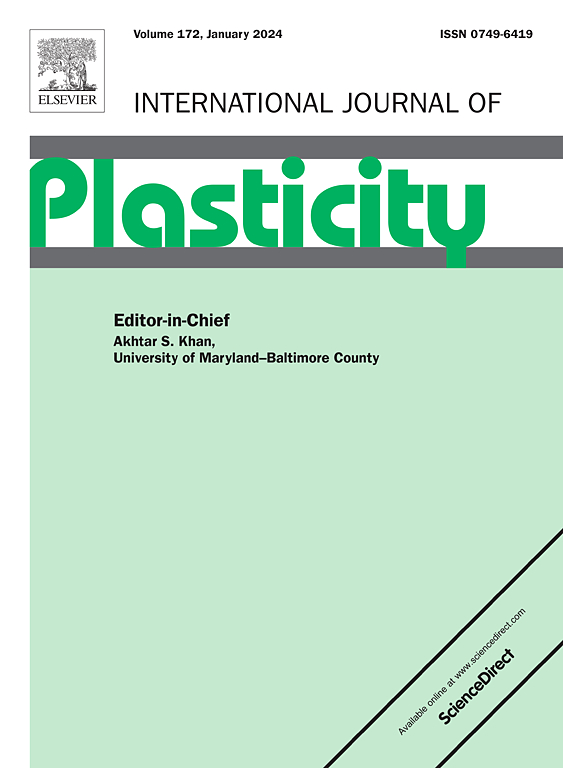增材制造Ti-6Al-4V合金的晶体塑性建模及疲劳寿命估算方法
IF 12.8
1区 材料科学
Q1 ENGINEERING, MECHANICAL
引用次数: 0
摘要
增材制造Ti-6Al-4V (AM Ti64)合金在关键承载应用中的有限使用源于对其疲劳行为、潜在原因和机制的不完全理解,以及缺乏可靠的预测建模。本研究旨在通过尝试帮助微结构敏感的模型与循环次数的失败来弥合这一差距。低周疲劳(LCF)试验在室温下以五种不同的应变幅值进行破坏,所有试验都注意到循环软化。建立了晶体塑性模型,并将其用于疲劳指标参数的分析。合成的微结构在统计学上与电子背散射衍射(EBSD)实验观察到的微结构相似。采用颗粒平均和带平均fatemi - society FIPs来评估裂纹萌生的可能性。这些FIPs是由CPFE模型的输出和每个应变振幅的体积平均得出的。在弹塑性试验之后,使用Gumbel极值分布分析体积平均FIPs中最高的5%。采用贝叶斯推理方法,将疲劳寿命与阀芯的Gumbel分布特征联系起来,结果表明,阀芯的疲劳寿命与试验数据具有较强的相关性。这项工作表明,可以建立FIPs与失效循环次数之间的一致相关性,为疲劳寿命评估提供预测工具。本文章由计算机程序翻译,如有差异,请以英文原文为准。
Crystal plasticity modeling and data-driven approach for fatigue life estimation of additively manufactured Ti-6Al-4V alloy
The limited use of additively manufactured Ti-6Al-4V (AM Ti64) alloy in critical load–bearing applications stems from an incomplete understanding of its fatigue behavior, the underlying causes and mechanisms, and the absence of reliable predictive modeling. This study aims to bridge this gap by attempting to aid a microstructure–sensitive modeling with the number of cycles to failure. Low cycle fatigue (LCF) tests are performed to failure at room temperature with five different strain amplitudes, with cyclic softening noted in all tests. A crystal plasticity model is developed and used for analyzing the fatigue indicator parameters (FIPs). Synthetic microstructures that statistically resemble the experimentally observed microstructure obtained using Electron Backscatter Diffraction (EBSD), are used. Grain-averaged and Band-averaged Fatemi–Socie FIPs are employed to evaluate the likelihood of crack initiation. These FIPs are derived from the output of CPFE model and volume-averaged for each strain amplitude. Following the elastic–plastic shakedown, the highest 5% of volume-averaged FIPs are analyzed using a Gumbel extreme value distribution. A Bayesian inference approach is used to associate the Gumbel distribution’s characteristics of FIPs with fatigue life, demonstrating a strong correlation with the experimental data on fatigue life. This work shows that a consistent correlation between FIPs and the number of cycles to failure can be established, offering a predictive tool for fatigue life assessment.
求助全文
通过发布文献求助,成功后即可免费获取论文全文。
去求助
来源期刊

International Journal of Plasticity
工程技术-材料科学:综合
CiteScore
15.30
自引率
26.50%
发文量
256
审稿时长
46 days
期刊介绍:
International Journal of Plasticity aims to present original research encompassing all facets of plastic deformation, damage, and fracture behavior in both isotropic and anisotropic solids. This includes exploring the thermodynamics of plasticity and fracture, continuum theory, and macroscopic as well as microscopic phenomena.
Topics of interest span the plastic behavior of single crystals and polycrystalline metals, ceramics, rocks, soils, composites, nanocrystalline and microelectronics materials, shape memory alloys, ferroelectric ceramics, thin films, and polymers. Additionally, the journal covers plasticity aspects of failure and fracture mechanics. Contributions involving significant experimental, numerical, or theoretical advancements that enhance the understanding of the plastic behavior of solids are particularly valued. Papers addressing the modeling of finite nonlinear elastic deformation, bearing similarities to the modeling of plastic deformation, are also welcomed.
 求助内容:
求助内容: 应助结果提醒方式:
应助结果提醒方式:


